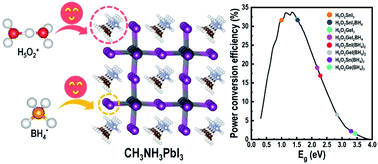ABX3-type lead-free perovskites using superatom ions with tunable photovoltaic performances†
Abstract
Expanding the family of ABX3-type perovskites is very important for developing excellent photoelectric materials. The perovskite-based H5O2+ superalkali cation had been explored, but perovskites with stable dynamics performance using superalkali and superhalogen ions are not yet found. In this work, H5O2+ and BH4− are introduced into a cubic CsPbI3 perovskite, and Pb is replaced with Ge and Sn, respectively. Then, cubic H5O2MIx(BH4)3−x (M = Ge and Sn; x = 0, 1, 2, and 3) perovskites are systematically studied by employing density functional theory-based first-principles calculations and ab initio molecular dynamics simulations. The calculated results indicated that the perovskites show a wide range of material properties, i.e., stable dynamics performance at normal temperature and pressure, suitable tolerance factors (0.86–1.00), tunable direct band gaps (0.96–3.28 eV), and small effective hole and electron masses (0.17–0.70 me). Moreover, a power conversion efficiency over 31% is obtained for single-junction perovskite solar cells based on the cubic H5O2GeI3, H5O2SnI3 and H5O2SnI2BH4 perovskites. These results indicate that the cubic H5O2MIx(BH4)3−x perovskites may be used for fabricating high-performance photoelectric devices, and an intriguing platform can be provided for developing other new stable lead-free superatom perovskites by using superalkali and superhalogen ions.



 Please wait while we load your content...
Please wait while we load your content...